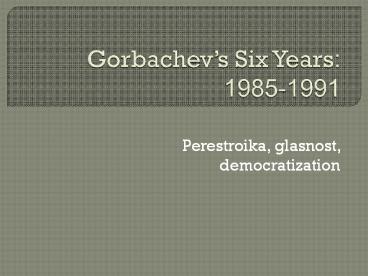Gorbachev - PowerPoint PPT Presentation
Title:
Gorbachev
Description:
Many reforms resembled those proposed by Sakharov Remained wedded to Communist Party Economic difficulties created by gradual reforms made him deeply unpopular. * * * * – PowerPoint PPT presentation
Number of Views:281
Avg rating:3.0/5.0
Title: Gorbachev
1
Gorbachevs Six Years1985-1991
- Perestroika, glasnost, democratization
2
the fateful Soviet years from 1985 to 1991
- when four great transformations - even
revolutions - were begun under the leadership of
Mikhail Gorbachev attempts to transform the
authoritarian political system into some kind of
democracy, the state command economy into a
market-based one, the Moscow dominated union
into an authentic federation, and the countrys
forty-year Cold War with the West into a
strategic partnership. (Stephen F. Cohen)
3
Gorbachevs Six years 1985
- Eduard Shevardnadze becomes Foreign Minister,
proclaims the Sinatra doctrine
4
Gorbachevs NemesisBoris Eltsin (1931-2007)
- 1985 December Gorbachev brings Eltsin to Moscow
to head the party apparatus for the city - 1987 Eltsin criticizes Gorbachev openly in
Committee, divested of power
5
Gorbachevs First Policy
- "Struggle against alcoholism May 1985-1990
- Clumsy program of destroying vineyards,
increasing cost of vodka, closing beer halls - Government propaganda created resentment
- Loss of 10 billion Rubles of state income
- Huge growth in production of samogon
6
Gorbachevs Six years 1986
- February March First mention of perestroika at
Party Congress - April Chernobyl disaster
- December Sakharov brought back from exile in
Gorky
7
Perestroika
- February 1986 27th Party Congress
- Objective acceleration of the economy,
overcome stagnation - Restructuring of the economy, injecting reality
into targets and prices, allowing enterprises to
make their own decisions, keep the profits from
new enterprises and production - Central planning and control remained half-way
solution
8
Gorbachevs Six years 1987
- January at Plenum of Politburo economic and
political reforms announced - Rehabilitation of victims of Stalin announced
- Eltsin attacks Gorbachev, resigns from Politburo
9
Gorbachevs Six years 1988
- The year of glasnost
- March Nina Andreyevas letter in Sovetskaya
Rossiya - May Law on cooperatives, allowing private
business - June Gorbachev proposes a new Congress of
Peoples deputies - December Armenian Earthquake, 45,000 killed.
10
(No Transcript)
11
The move to a free economy
- Inspired by the NEP (Lenins New Economic
Policy) of the 1920s - May 1988 Law on cooperatives - essentially
private businesses - approved - Private banks began to be allowed
- Russian businesses permitted to deal with foreign
partners directly
12
Problems with perestroika
- No rules to govern private economy laws,
contract enforcement - Criminals quickly learned to exploit system
take-overs of businesses, protection rackets - Prices not decontrolled budget had huge deficit,
money printed to cover deficit led to huge
increase in real price inflation - Profits syphoned into offshores
- Shortages continued perestroika discredited
13
Glasnost
- Theory Open discussion of problems as a means to
achieve real efficiencies - By 1988 censorship lifted from literature, film,
the arts. Now Soviet citizens can read anything - Led to questions about blind spots of history
Katyn execution of Polish officers, the hidden
protocols of the Molotov-Ribbentrop pact of 1939,
the Gulags and Stalins show trials, esp. Nikolai
Bukharin
14
Molotov-Ribbentrop PactAgreed division 1939
(left) Actual division 1940 (right)
15
Democratization
- Approved by 19th Party Conference in July 1988
- Objective Transfer of control of state from
Party to semi-elected Congress of Peoples
Deputies and Supreme Soviet elected by it - 750 members from districts, 750 from territories,
750 from public organizations including 100
from Communist Party First meeting 1989. - 15 March 1990 Congress elected President of the
USSR.
16
Gorbachevs Six years 1989
- January February withdrawal from Afghanistan
- March-April Elections to Congress
- June Tianan Men Square incident in China
dissidence suppressed - 9 November Berlin Wall comes down
- November December Communists ousted throughout
Soviet bloc GDR, Hungary, Czechoslovakia,
Romania. - December 14 Sakharov dies
17
Nationalism
- Open discussion of Molotov-Ribbentrop pact
- As central power was loosened, republics begin to
demand their languages be given prime status over
Russian Ukrainian, Georgian, etc. - Baltic Republics Estonia, Latvia, Lithuania and
also Moldova (formerly Bessarabia) demand and
start to declare their independence
18
1990 A fateful year
- Germany is being reunited
- Other Soviet bloc members do it their way
- Gorbachev is awarded the Nobel Prize for Peace
- Gorbachev chosen president of the Supreme Soviet
of the USSR - BUT crisis looms in Soviet leadership Yakovlev,
Shevardnadze forced out in December. Is another
Tiananmen looming?
19
Gorbachevs Six years 1990
- September 9 Alexander Men murdered
- September Battle over 500 Days reform program
for economy
20
Gorbachevs legacy
- Ended Cold War
- Brought the USSR out of Afghanistan
- Moved USSR towards elected democracy and free
economy - Nearly succeeded in saving a reformed USSR
21
Gorbachev and ideology
- Was he a dissident or a Menshevik?
- Many reforms resembled those proposed by Sakharov
- Remained wedded to Communist Party
- Economic difficulties created by gradual reforms
made him deeply unpopular.































